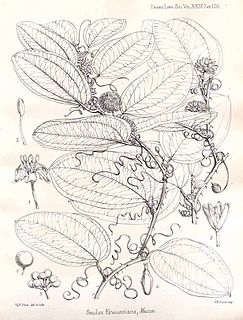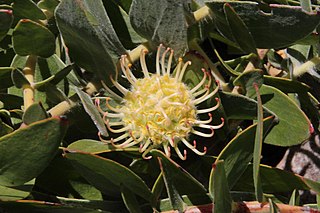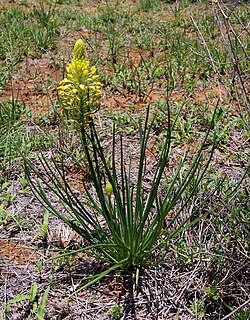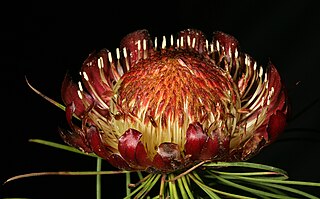
Centranthus ruber, also called red valerian, spur valerian, kiss-me-quick, fox's brush, devil's beard and Jupiter's beard, is a popular garden plant grown for its ornamental flowers.

Leucadendron argenteum is an endangered plant species in the family Proteaceae, which is endemic to a small area of the Cape Peninsula, South Africa. Most grow in and around the city of Cape Town, but outlying populations exist near Somerset West (Silwerboomkloof), Paarl and Stellenbosch. It is a protected tree in South Africa.

Protea welwitschii is a species of shrub or small tree which belongs to the genus Protea, and which occurs in bushveld and different types of grassland.

Astroloba rubriflora is a succulent plant found in the mountainous Karoo area around Robertson, South Africa. It is listed as a Vulnerable species on the IUCN global Red List.

Pigeon Valley is a Natural Heritage Park and formally declared municipal nature reserve in Durban, South Africa. It is an unusual example of an urban reserve with very high levels of biodiversity. It was established to provide protection for the Natal elm and other forest giants of the coastal climax forest. Another rare tree that occurs here is Natal forest loquat, which is endemic to the Durban area and to oNgoye Forest. Pigeon Valley is about 11 ha in extent, and is situated on the Berea, overlooking Durban Bay. Its unusual north-south orientation may contribute to the biodiversity, with the south-facing slope covered in canopy forest, while the north-facing slope has thorny thickets. An adjoining reservoir, previously part of the reserve, provides a patch of coastal grassland.

Smilax anceps is a vigorous scrambling vine or shrub, and is one of some 278 species in the genus Smilax in the family Smilacaceae. The species is widespread in Tropical Africa, Southern Africa, Réunion, Mauritius, Comoros, and Madagascar. The specific name 'anceps' is Latin for 'dangerous', a caution against the hooked prickles. Tarundia cinctipennis Stål, 1862, a hemipteran insect, is associated with this plant.

Protea acaulos, also known as the common ground sugarbush, is a flowering plant found in the southwestern Cape Region, South Africa. It is also simply known as ground protea; in the Afrikaans language it is known as an aardroos.
The South African National Biodiversity Institute (SANBI) is an organisation established in 2004 in terms of the National Environmental Management: Biodiversity Act, No 10 of 2004, under the South African Department of Environmental Affairs, tasked with research and dissemination of information on biodiversity, and legally mandated to contribute to the management of the country’s biodiversity resources.

Scutia myrtina is a species of plant in the family Rhamnaceae. It is commonly known as cat-thorn.

Leucospermum cordatum is an evergreen, creeping shrublet of about 20 cm (8 in) high from the family Proteaceae. It has pale cream flower heads, from which pink flushed styles emerge, the whole reminiscent of a pincushion. Its common name is heart-leaf pincushion in English. It flowers between July and December but the peak of the flowering period is from September to November. It is an endemic species, that is only known from two locations close to each other in the Western Cape province of South Africa.

Bulbostylis hispidula is a plant native to South Africa, Swaziland, Botswana, and Namibia. The subspecies pyriformis can be found in all South African provinces except Western Cape. On the SANBI Red List, it is listed as "safe" (LC).
Drypetes gerrardii is a species of small tree or large shrub in the family Putranjivaceae. Common names include forest ironplum, bastard white ironwood, and forest ironwood. It is native to tropical and subtropical central and eastern Africa. It was first described in 1920 by the English botanist John Hutchinson, who named it after the English botanist William Tyrer Gerrard who collected plants and seeds in southern Africa in the 1860s.

Bulbine abyssinica is a species of plant in the genus Bulbine, from eastern and southern Africa.
Oedera imbricata is a prickly shrublet belonging to the daisy family.

Asparagus mucronatus ("Katdoring") is a thorny shrub or creeper of the Asparagus genus, that is indigenous to the southern Cape regions of South Africa.

Protea effusa, sometimes known as the scarlet sugarbush, is a flowering plant which belongs to the genus Protea. The plant is endemic to the Western Cape province of South Africa. In the Afrikaans language the vernacular name blosrooisuikerbos has been recorded for this plant.

Protea angustata, also known as the Kleinmond sugarbush, is a flowering shrub that belongs to the genus Protea. This plant is endemic to the south-west Cape Region of South Africa.

Protea pityphylla, also known as Ceres sugarbush or mountain rose, is a flowering shrub of the genus Protea, in the family Proteaceae. The plant is endemic to the southwestern Cape Region of South Africa.
Protea nubigena, commonly known as cloud sugarbush, is a very rare species of a flowering shrub belonging to the Protea genus. It is endemic to KwaZulu-Natal, South Africa and is found in the uKhahlamba Basalt Grassland within the Royal Natal National Park, near Mont-Aux-Sources, at an altitude of about 2,250 metres (7,380 ft) in well-drained, humus-rich soil on shaded slopes.
Protea convexa, also known as large-leaf sugarbush, is a rare flowering shrub in the genus Protea of the family Proteaceae, which is endemic to the southwestern Cape Region of South Africa.














